Featured Text
Calder’s International Monuments
Art in America, vol. 57, no. 2 (March–April 1969).
Art in America, vol. 57, no. 2 (March–April 1969).
At heart, Calder has always been an engineer. He has clothed the forces of his engineering with his joyful imagination and his lithe sense of beauty. But the wellspring of his art remains the thrusts, the tensions, the stress loads, the balances, the forces of gravity which he, the engineer, proceeds to adjust and join.
From the very start, from the “workings” of his Circus to the resulting wire sculpture and incredible creation of the mobiles, one observes his essential preoccupation with a logical, elegantly supported, immaculately balanced sculpture.
What has been most exciting to watch is the endless change and development of his creative process. Essentially simple and direct in its approach, never pompous or bombastic, that process has allowed him the greatest freedom in seeking the various combinations and mutations of structure, form and movement. And as with any engineer worth his salt, or any artist for that matter, the endless search goes on.
Of late Calder has turned toward monumentality and all of the massive problems this provides him. There has been a great deal of monumental sculpture set up in this world—at tremendous pain. Most of it turned out to be mediocre beyond belief because it was “monumental.” The low-priced chiseling hand, the tiring back muscles and finally the easily satisfied artisan’s eye faltered, leaving us coarse, often flatulent replicas of fine smaller works. With Calder this is not true; in fact this newly mastered size often imparts an added vitality and force not to be found in the small maquette or even its intermediate-stage development. Too, a grandeur is becoming even more apparent in each succeeding piece.
It is worth noting that the same extraordinary ingenuity which now marks the conception and creation of these monumental pieces has been characteristic of Calder almost from early childhood. I suppose that nowhere in the entire stream of art, from Paleolithic man’s solid stone sex symbols through Rodin, Maillol and Matisse’s “solids” (for like “mobiles” and “stabiles” it is the only word one can apply to them), has one man, single-handed, in the span of half a lifetime, created, full-blown, an entirely new concept of sculpture. This is genius at its best.
Normally, an artist has learned laboriously from his heritage and his immediate predecessors and then slightly altered these gifts. But not Calder. He fought off his father’s solid teaching, admonishments and deprecatory remarks and brought forth his entirely new concept of sculpture.
This is not easy to do in any field, and it is one of the marvels of Calder that he lifted off into space and then proceeded to slice it up or pierce it as no one ever had before. Now in full command of his materials and armed at last with honor (which is never a detriment for any man), he can achieve the nobility he desires through a variety of new avenues, steadily explored and extended.
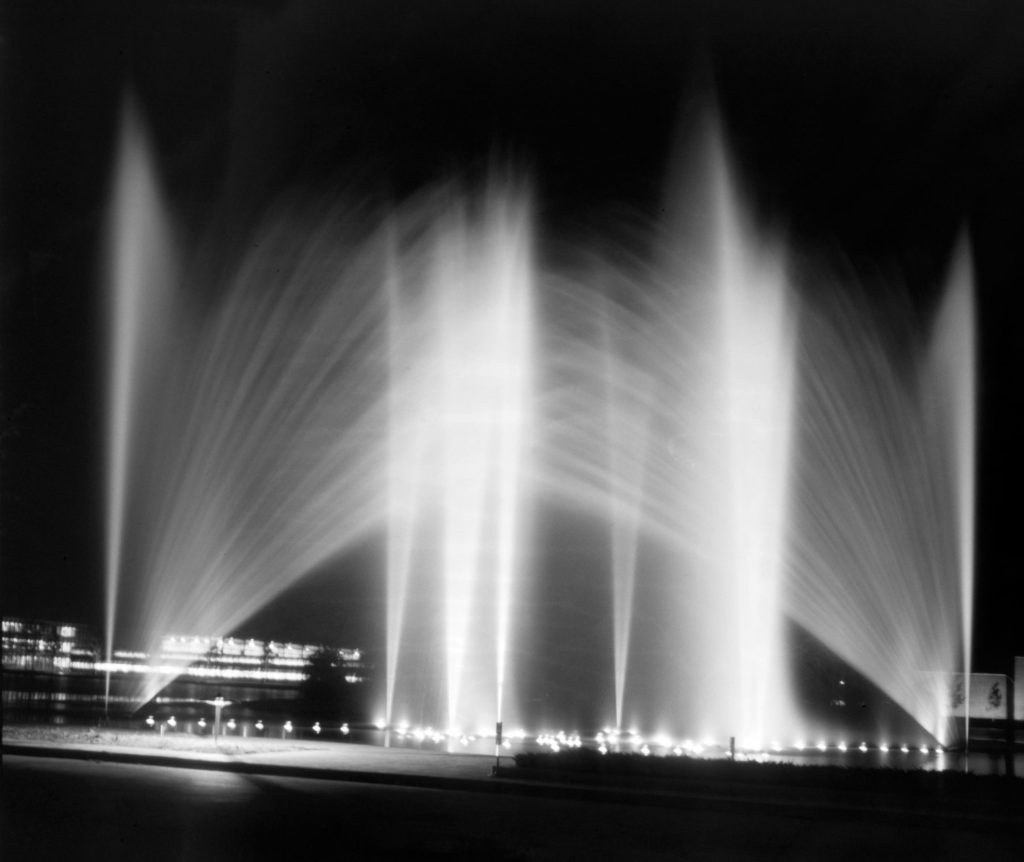
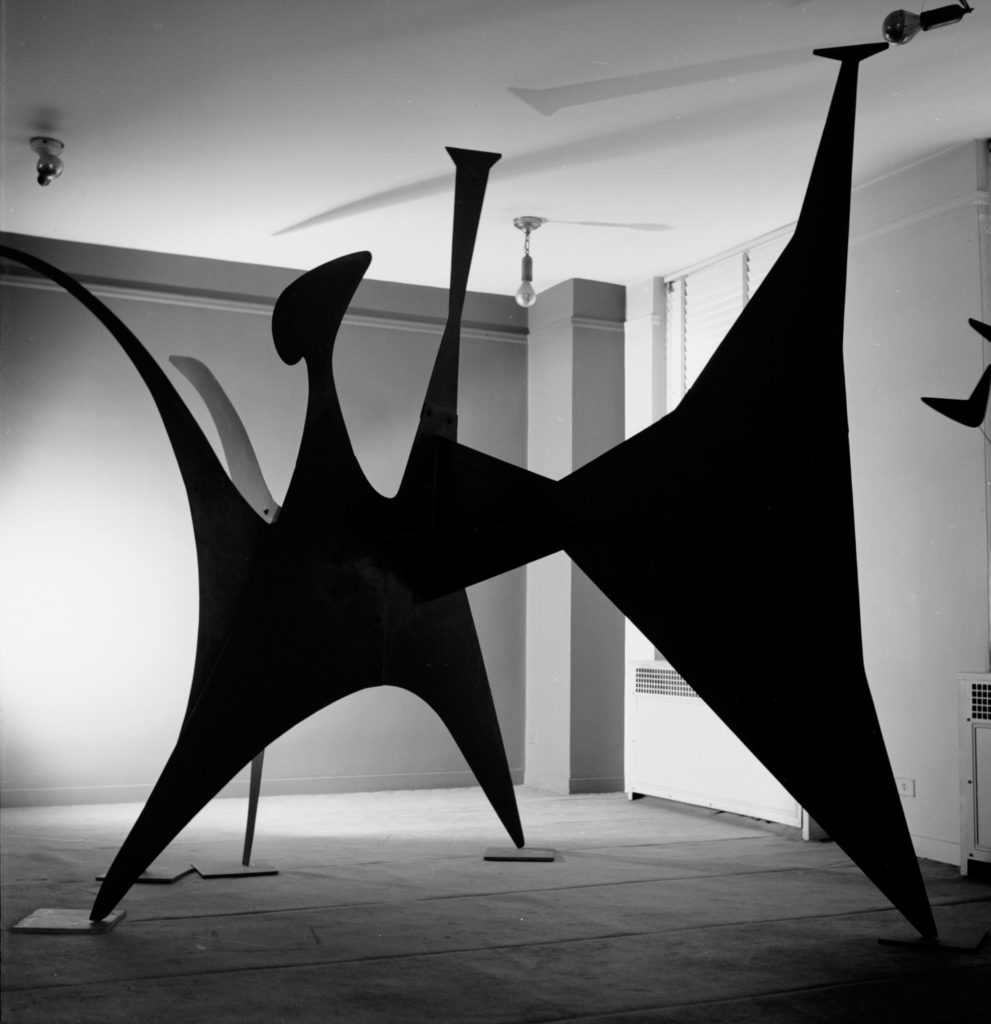
Sandy, how did the increase in scale start?
Well, in 1954 I’d done the Water Ballet for Eero Saarinen’s General Motors Technological Center in Detroit. The concept there was a large one, I’d say. Jets of water. Lines of water can be monumental too. I took one hundred feet and had one jet at each end rising and falling at different speeds, and then that comes to a halt. There were seven smaller jets that were almost vertical; I called them the seven sisters because they were slender jets, and some rotated one way and some the other way and they made a rotating pattern against the sky. Then there is a bathtubful of water shot into the air to make a big boom when it hits. Then a bar rotating makes a fishtail—that’s rather fine. They wanted the ballet, but now they are afraid to run it because the stockholders have complained that it costs money to run—probably waters their stock down—so it’s only turned on for VIPs. I’m afraid I probably won’t ever see it.
I did see it once when it was turned on, and it has tremendous fragile size to it, and a magnificence such as the Lincoln Center waterworks lack.
They probably haven’t got the pressure there.
When did the large metal constructions begin?
It was when Eliot Noyes asked me to remake an object I’d made earlier to show at Pierre Matisse—The Black Beast—only make it of thicker metal. Before this I’d done Kennedy, which was heavy enough to flatten an ox if it fell. I’ll tell you about that later—and I’d already done the one in 1958 for UNESCO in Paris and that was a pretty good size, but now I had the impulse and the means (two thousand dollars) to make things at a larger scale of one-quarter-inch iron plate. So, I decided to have a show of fairly large stabiles at Perls in the winter of 1958. We sold three of these, and in the winter of 1959 I sent the remainder of the Perls show to Paris with a number of other objects, about ten large stabiles I’d constructed for a show at Maeght’s. Mrs. Maeght said, “You must have really had to scratch your brains to produce these things.” But the night before the show opened they phoned me that they’d bought the whole show. This was the first time this had ever happened to me. So now I wanted to repeat my “triumph,” and this time I had in mind something which could stand in that central inner court of the Louvre—you know the one.
The one that’s closed on four sides?
Yes, but the French Government wasn’t interested. They said they couldn’t do it because it would disturb the flat beds of flowers.
They will be interested, have no fear. Give them time. The bureaucrats always lope up late.
It’s getting late. Well anyway, Maeght was going to do over his gallery, lower the ceiling in order to put in a fancy new lighting system. I said, “Shit, that won’t do at all.” In order to show the big objects I had to have the full height of the gallery, and in order to make them I needed a show like those in Waterbury. Jean Davidson—he’s my son-in-law—and I had discovered ironworks in Tours, the biggest one in France, so we went to ask if they’d make some big stabiles. A nice guy in a tweed jacket said no but kindly gave us the name of Biémont. They are just on the edge of Tours. I brought them eight models in the early fall of ’62 and left for America. When I got back to France they had them all done. All eight pieces. They were standing there! The biggest one was six and a half meters high. They pleased me. I could begin to see the possibilities.
Tell me about the Biémont ironworks. How many men are employed there?
Between sixty and eighty work in the plant, but only three or four work on one piece.
Have certain men become specialists and therefore improved in doing your things?
Yes, but now they are all becoming “art critics.”
But I should think it would be handy to be able now to just produce the model and then know that they can enlarge it without loss of power.
Yes, it’s almost ideal now. But I always like to have a finger in the pie.
While we’re on it, talk about the enlarging process.
I used to make a small model, then cut out full-sized parts in paper. Then the ironworks in Waterbury would translate these paper templates into metal pieces. Now the Biémont people are so trained that they make the templates themselves. Even Waterbury can do this now. The guy in Tours has a real mechanical department. They do real calculating. They can tell beforehand where to place the ring to hold it up, and they can tell which hole to hoist it up by so all the holes will line up with the holes in the plates which are already up.
What about the treatment of edges—because I should think so much force and beauty could be lost there. How much do you have to do with the final contours?
In France, they are very good—very careful. I look at the pieces every once in awhile. Sometimes I throw my hands up and say “Shit!” Then they grind down the mistakes. Sometimes the final line is a little different. Maybe it lends a little variant.
I’m always amazed how your studies stand enlargement with no loss of vitality. In fact, the carefully conceived ribbing often increases the essential force. Tell me about the evolution of the bracing.
I try something new each time. With the model at three meters you can wobble it and see where it gives, where the vibrations occur, and then put your reinforcement there. If a plate seems flimsy, I put a rib on it, and if the relation between the two plates is not rigid, I put a gusset between them—that’s the triangular piece—and butt it to both surfaces. How to construct them changes with each piece; you invent the bracing as you go, depending on the form of each object.
This must account for the fact that the ribbing with its shadows has by now acquired an esthetic of its own which is there to be enjoyed along with the strength of the engineering.
I crossed the Atlantic once on the “Bremen.” The partitions were all going “Baaroop, baaroo, baaroop, baaroo.” That’s what you have to avoid.
Incidentally, Sandy, think of trying to increase a splendid Maillol figure to forty or fifty feet—the lymph would be going out of it foot by foot.
The lymph goes out of the nymph!
But your six-inch concept is so solidly related that it can go up like a Corbusier building, simply gaining magnificence as it increases in scale and massiveness.
One key to this great sculptor is the fact that both of his parents were artists—as was his grandfather—and good ones too, and then he, the obstreperous bounce-out, turned into an engineer, and then, as he says, bounced back to become artist and engineer combined. It is this fortunate union, this rare combination, which is producing the latest beauty and gigantic vitality in Calder’s work. As one thinks of it now, the word which comes to mind most often is magnificent. Calder will probably finally get to the stars, single-handed, propelled there no doubt by some circus rig of his own, flinging him end over end into space—his natural possessed element.
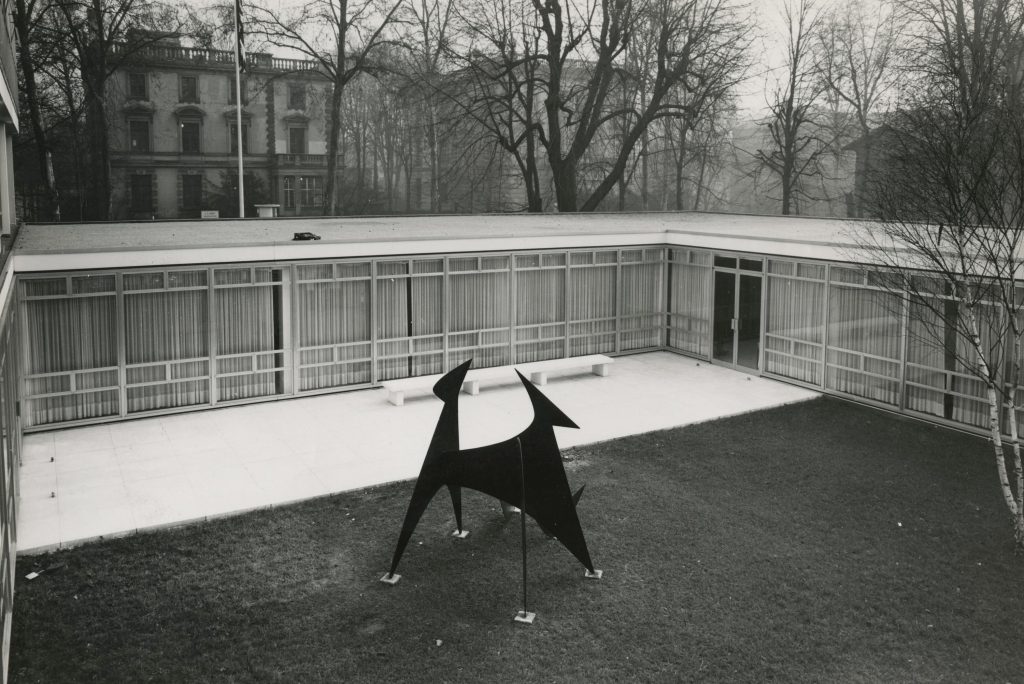
Hextoped, 1955, U.S. Consulate, Frankfurt, Germany. (All works are in painted sheet steel unless otherwise indicated.)
How did this one come about?
I had the job to do it for Bunshaft. I knew the head of Amerika Haus in Frankfurt, and he introduced me to a bridge builder, Fries. They built the object for me in two days; it was all ready to be welded, but the Consulate didn’t seem to be ready to receive it. So I called Ambassador Conant in Bonn and told him I wanted to put it up and then things began to move. We had to get a Marine Sergeant to unlock a door so we could get out the 368—or 386—volts for the welding machine. Then we welded it together in the courtyard of the Consulate. They’ve sent it out on exhibition since then, so they must have had to lift it out over the roof. Now it’s placed on the front lawn.
Pittsburgh, 1958, mobile at Greater Pittsburgh Airport.
I won the Carnegie International with this in 1958. We had to install it in a horrible stairwell. I made my object twenty-seven feet high and twenty-seven feet wide, and Chippy Ieronimo and I put it together in the Waterbury foundry using window weights to represent the first three lower bars so that it would balance absolutely right. Eventually they had to represent 135 pounds. We’d read the number on the window weight and then hang it on. I never saw the final thing put together at all until we went to Pittsburgh later to install it at the airport. The mobile was purchased by David Thompson at the International and given to the airport.
When we went to the airport to put it up, they had all sorts of journalists standing around asking us this, that and the other. I was trying to concentrate on getting the thing up. One of those guys asked me, “How long did it take you to make that?” I said, “Two or three months.” Then I reconsidered and went back to him and said, “Hey, it took me thirty years.” Those dolts just looked at me and then walked away.
When Thompson bought it from the Carnegie, it had white paddles and black bars. The guys at the airport wanted it to be the county colors, so they had it painted yellow and green.
County?
Yes, county. I suggested that they repaint it and said, “Paint it red.” I sent them four little cans of my color, but they must have diluted it because now it’s pink.
Man! The trials of the artist versus “they”!
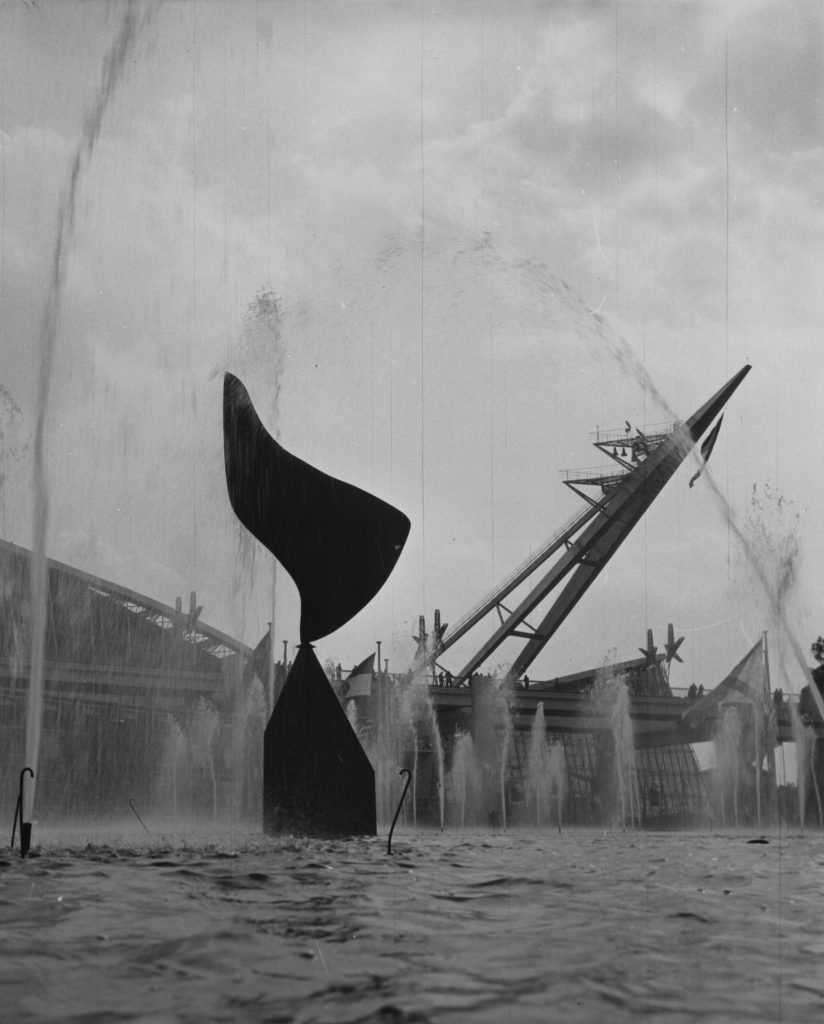
Whirling Ear, 1958, set in pool outside U.S. Pavilion, Brussels World’s Fair.
There’s a little story about this. This one was built by Knight in Watertown, Connecticut. He had a young Scotchman working for him. I asked for two turns a minute and called it The Whirling Ear. Then I asked the Scot if he could reduce it to one turn a minute. He said, “Then you’ll no be calling it The Whirling Ear.” It was about twenty feet high and made from a twelve-inch model. The top is aluminum, the bottom is iron. The whole thing was painted black and the motor was inside it.
Back From Rio, 1959, Swarthmore College, Swarthmore, Pennsylvania.
Where did that name come from? It’s kind of high-flying!
Fifteen feet high. In 1959, I took six or eight pieces to Rio. They were going to buy them, but then they seemed to run out of money, so I had to bring them all back. No—in spite of everything, two remained down there. They were bought by Lota de Macedo Soares, that wonderful woman, and set up in the big park that she was designing for Rio. When this one got back it was pinked out by the sun in Rio. It was bought by Swarthmore as a memorial, and I’m glad to say it’s been repainted.
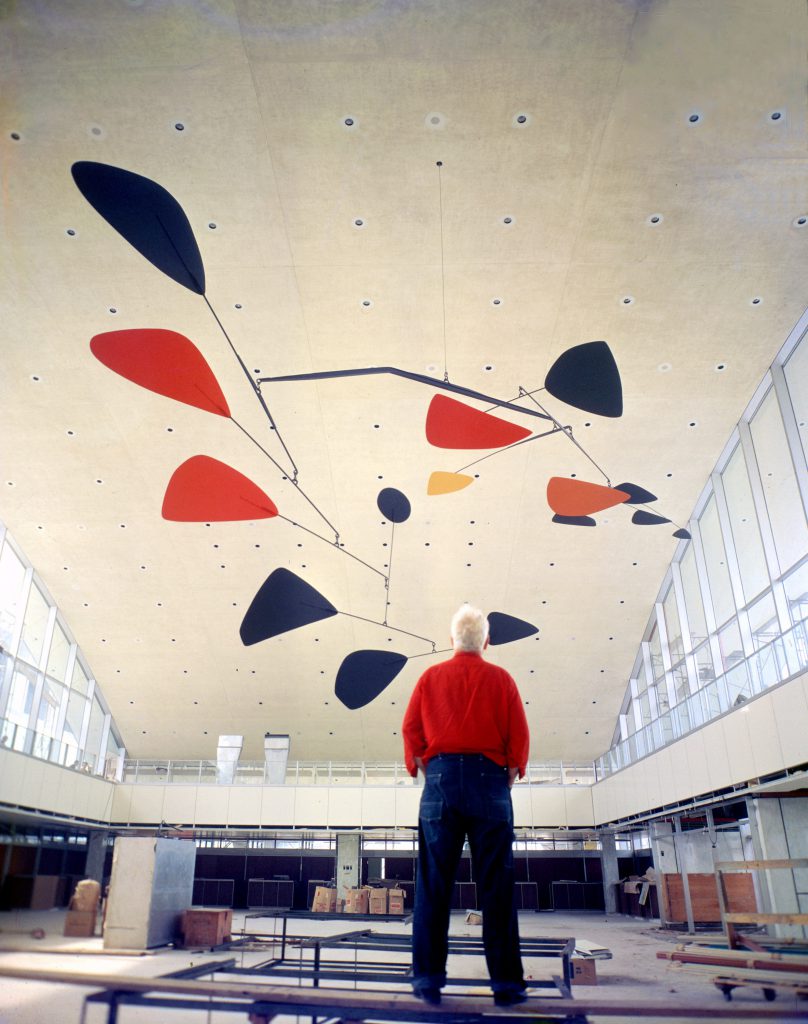
.125 (thickness of metal of which the plates are made), 1958, Kennedy Airport, New York.
How do you think of the relation between the mobile at Kennedy and the large stabiles?
People think monuments should come out of the ground, never out of the ceiling, but mobiles can be monumental too. Bunshaft had a model of the space at Kennedy. I made three models to scale, seventeen inches wide. The one that was bought had to be blown up to forty-five feet wide. Chippy Ieronimo at the Waterbury foundry made the big one.
Were there any structural problems?
No, only their problems.
What do you mean?
There was a three-quarter-inch stainless-steel cable at the first arch that had to be spliced on the spot. The guy’s sweat fell down so much on the big black plaques I thought they’d been having tea up there in the air. Unfortunately, they used so much energy hoisting it up they bent a bat. So, on Monday, we had to go up there and put in a flat triangle to hold it together.
Two years later they took it down for Christmas to put up a big paper Christmas bell. When they put the mobile back up they didn’t get it up right, so I was called in to prescribe again. They’ve learned their lesson; no more paper bells—I hope.
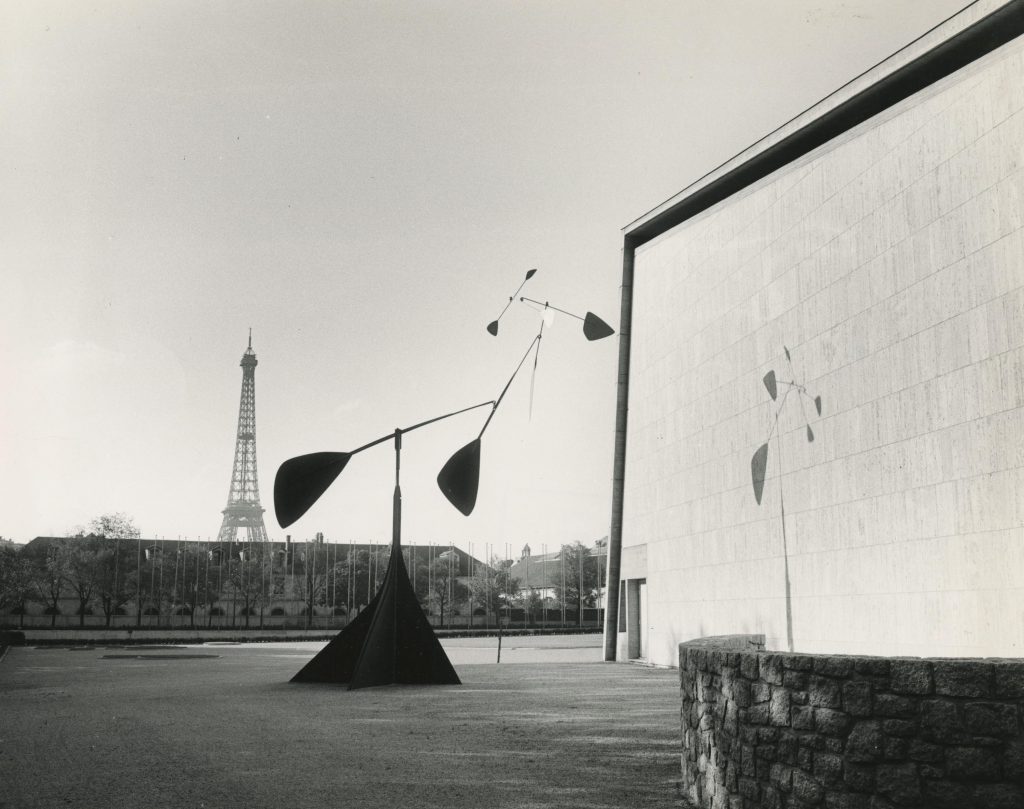
Spirale, 1958, UNESCO Building, Paris.
This was very nice. I made two models, Breuer selected one. I built everything that revolves in Waterbury, Connecticut. We were very cramped there—no headroom. To get the angles, Carmen Segre [the owner of the Waterbury foundry] wanted to see if it would work. So we set up a derrick and supported it from above. It did work. We painted it there and sent some extra Japalac paint in a little box with the S hooks. Several months later in Paris, they couldn’t find the hooks or the Japalac. A painter who had liked Noguchi when he did his garden had put all of the Japalac in the Jap, alack, rock garden. The S hooks we finally found.
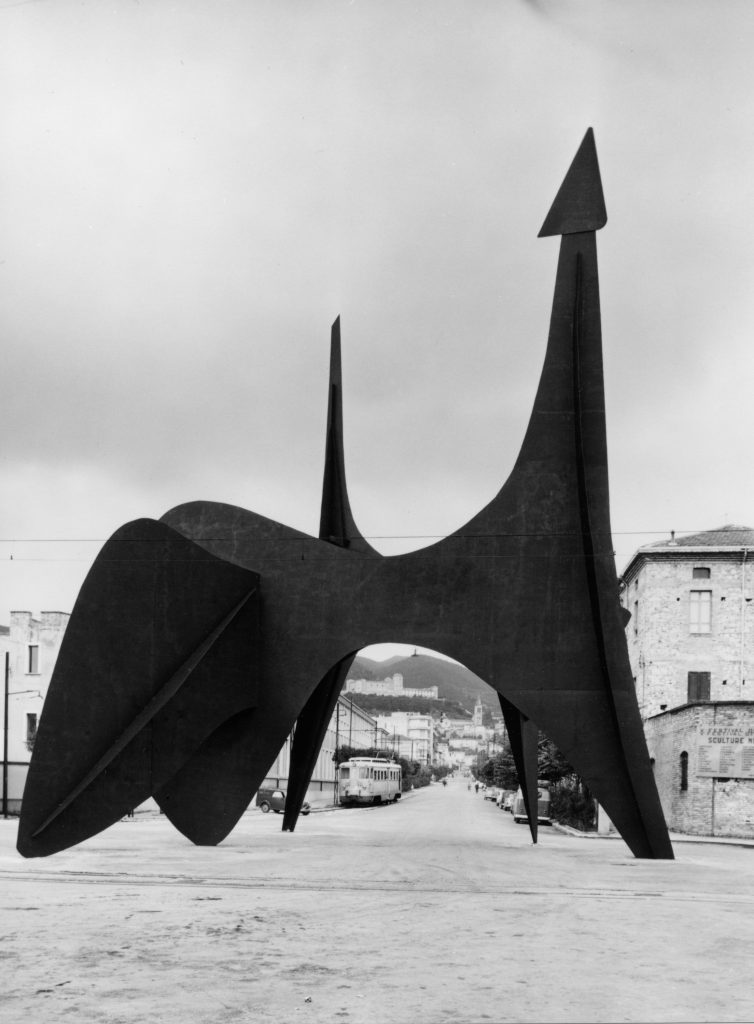
Teodelapio, 1962, Spoleto, Italy.
Which was the first really monumental stabile—Spoleto?
Yes, Giovanni Carendente, assistant director of the Museum of Modern Art in Rome, organized the outdoor sculpture for Spoleto in 1962. I had had a show at the gallery L’Obelisco in 1956. I met him then. He wrote me in Roxbury, asking for my collaboration. One object lent itself to that large scale. Because it was to arch the crossroads at the entrance, I made the model higher in the crotch—thirty inches long, thirty inches high. Italsider, a shipbuilder in Genoa, built the thing. They put it on an enormous trailer truck to bring it to Spoleto. Using two cranes, one to hold it and one for the welder, they put it up the way they build a ship. Unfortunately, I didn’t see the operation. Carendente said they needed reinforcements; Sweeney wrote a postal, “Come quick, danger.” Jean and I spent three days trying to get Carendente on the phone; finally I flew to Rome, took a train to Spoleto—there it is right in front of you at the station. I had a fine time with Carendente, suggested various flanges to stiffen it. That was done and it’s still there.
Was it fun to do something that large?
Yes. People keep giving it a phallic meaning. I wasn’t aware of any such influence, but that may give it its nice force.
Incidentally, the name of it refers to the Duke of Spoleto.
After Spoleto, I exhibited some other large pieces with other sculptors in Amsterdam and Stockholm.
[The general growth process now began; one development led to another. Seeing the larger piece, Calder was inspired to do others, to try things at a new scale. The Spoleto piece was successful despite the need for better reinforcement. This need was from then on well considered, and the ribbing was carefully planned.]
Four Elements, designed 1939, executed 1962, Moderna Museet, Stockholm.
Tell me about the Four Elements in Stockholm.
Well, they are thirty feet tall.
What makes them turn?
Each one has a separate motor, an electric motor housed in the base of the sculpture.
What year was this made? I find it marvelously fresh and full of life.
I had two models, thirty inches high, which I had made for the World’s Fair in 1939, and no one even looked at them. When Hultén at the Moderna Museet came along I showed them to him and he liked one. Then, once given the model, no one came back to me.
It’s a help when they can be produced that way. I think it would be great if this could happen from now on. You make the models and simply turn them over to highly trained technicians for enlargement.
Le Guichet, 1963, Lincoln Center, New York.
Was Le Guichet selected from a group of pieces or done for the space? Moore’s piece looks as though it were done for the water, yet he complains properly “They didn’t give me the water they promised.”
Mine was selected, not done for the space. It’s too small for that spot. But the pigeons like Henry Moore than me.
Triangles and Arches, 1965, for South Mall (under construction), Albany, New York; Têtes et Queue, 1965, New National Gallery, Berlin.
I made that to have in the 1965 exhibition at the Musée d’Art Moderne in Paris. It will eventually go to the new Albany Mall and stand in front of the new building there. While I was making this one I also produced the Têtes et Queue. Werner Haftmann saw it in Paris and asked for it. Wietzhold came from Berlin and checked it, then thanks to money which came from the Springer Publications, it now stands beside Mies’s new museum of modern art in Berlin. Springer had it set up for a while against The Wall, until the museum was finished.
Peace, 1965, courtyard of the U.S. Mission to the United Nations, New York.
How did this installation come about?
Apparently I was very nice to Mrs. Goldberg a long time ago when she saw my work at a show in Chicago. She always admired me for that reason, and so she asked me to do something for the United Nations. I wanted to do something for peace. One night when I was coming home on the train I saw this stabile standing outside Carmen’s shop in Waterbury with the light on it and decided that it would be appropriate for the U.N., so I gave it to them.
Crossed Blades, 1966, Sydney, Australia.
This was a nice commission. Harry Seidler, an architect, trained at Harvard, wrote me one day at Roxbury. I was in Saché; the letter finally came to Saché. Just as we were leaving for Roxbury, he showed up in Saché. Jean Davidson had him to lunch and discovered what the Australians wanted. Seidler said, “They have a tall tower by Nervi [Australia Square Tower] and need a piece by Calder.” I have always thought that Nervi was a wonderful guy, so I wanted to help and I built something.
The whole thing was shipped by boat around the Horn because the Suez Canal was out of commission at the moment. Seidler wanted me to come out to set it up—and I said I really couldn’t. I thought that he could probably get it up. He, of course, did.
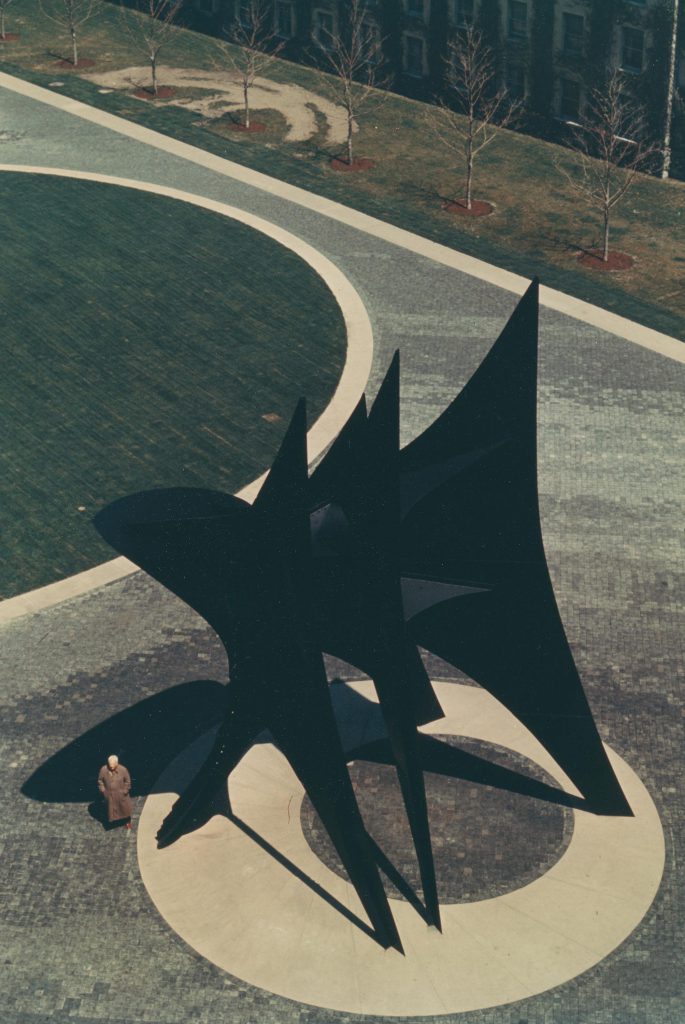
La Grande Voile, 1966, Massachusetts Institute of Technology, Cambridge, Massachusetts.
This one really knocked me down when I saw it. As one looked at the Voile a whole new set of elements, mostly crossed flanges, seemed to have entered the problem. Too, the ribs (the bracing) appeared bolder and cast deeper shadows, and they were beginning to assert their esthetic clearly.
This, of course, changes too with the sun. Let me tell you a little story. The first model I made I didn’t like. Then I did another one, and they liked it; so we made an enlargement exactly to scale, eight feet high. From that model we went to the final piece, forty feet high. This we did in France. Since then we’ve always made a one-fifth scale model—to study the overlapping of the plates and the piercing of the holes.
The Spinner, 1966, Dayton’s, Nicollet Mall, Minneapolis, Minnesota.
It is six meters high, and it has a mobile head on top and two or three disks that go around. They are slanting disks to catch the wind, and will go around much faster, I imagine, than vertical disks. The center part has ball bearings at the top and the bottom to increase the speed.
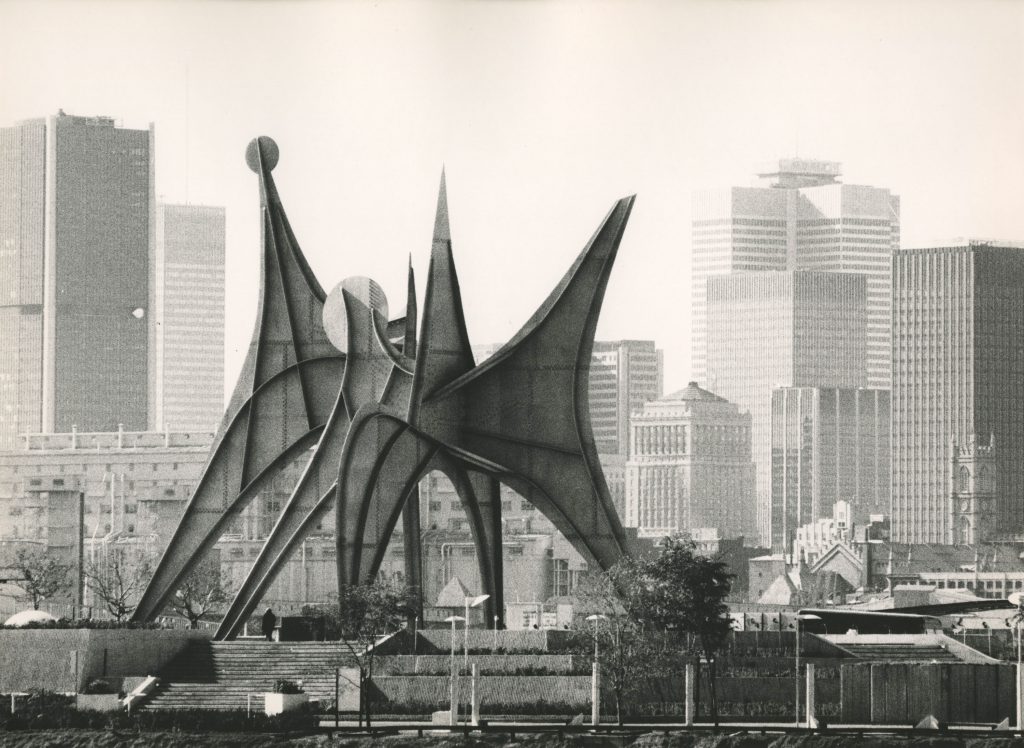
Man, 1967, Expo 67, Montreal, Canada.
I called it The Three Disks; they called it Man. They wanted it bare, which was natural because the Nickel Company put up the money, so they wanted it to look like nickel. It took almost a year to make because they had to install new machines to cut the stainless steel. All the metal it was made from came from Canada, and a lot of the material was sent over to France—not quite according to specification. Some of it had to be pared down and flattened out. That took some more time, and more money.
By now, the Fair was getting closer and closer. We had to get things moving and get it up. There was a big luncheon and honors in France for the send-off. Finally it was put into twelve cases in twelve flatcars, and they went on a Russian ship from Antwerp, and when we got to Montreal the erecting crew were all red Indians, American Indians. They have no fear of height and they work in the air without any safety belts. At Biémont they always wear safety belts putting up the big ones. I had two men with me from Biémont, and they assisted the Indians by handing them the right-length bolts.
We had some trouble with the bracing. The pieces had to be cut there, but the workmen who did that were sloppy. They just chopped up the metal bands and they were gondolé. They all had to be filed and straightened out. But we finally got it up.
Les Trois Pics, 1967, Parvis de la Gare, Grenoble, France.
I was asked to do something for the early ’68 Winter Olympics, so I made an object of three rough triangles, each with a point piercing the next one. We got M. Gibson to come look at it in the shop. It was lying down because it was too tall to be put up inside the shop. He accepted it, and we put it up in front of the station in Grenoble.
There was a big group of sculptures there, and the people didn’t like any of it very much; they kept saying the city shouldn’t have spent the money on it. Now they are very proud of it. One journalist wrote me, “We like it so much we wish you’d make it bigger.”
Gwenfritz, 1976, Smithsonian Institution, to be installed on the Mall, Washington, D.C.
I wanted great jets arching as from fire hoses over and in front of the piece and coming from the pool—they said: “No, everyone will get wet.”
The title is for Gwendolyn Cafritz who donated the piece to the museum.
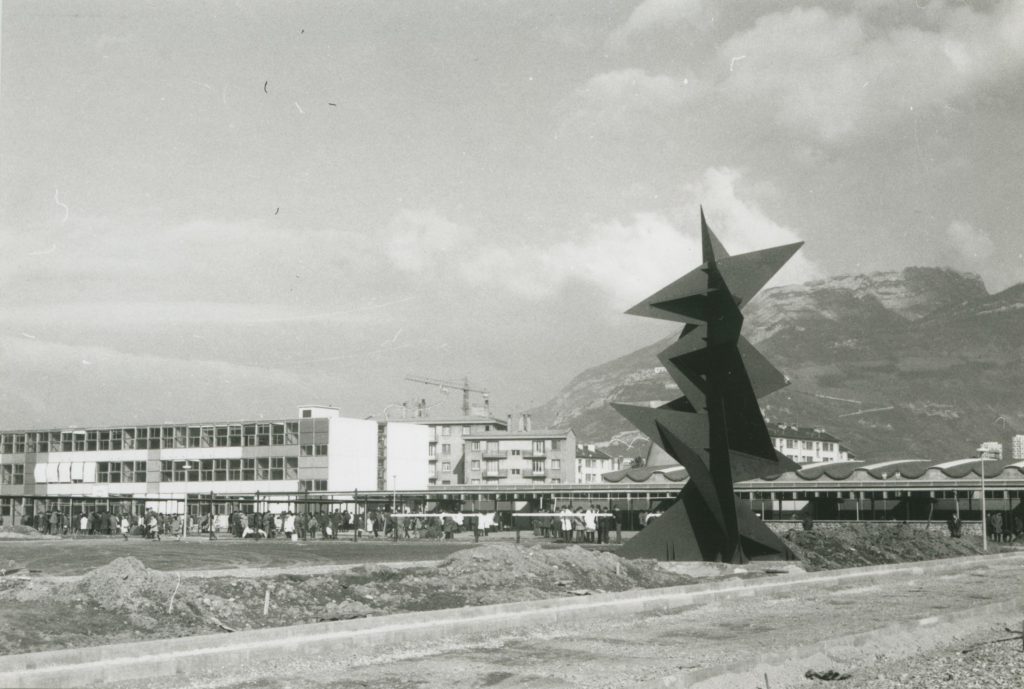
Monsieur Loyal, 1967, Ecole Jean Bart, Grenoble, France.
What does the name mean?
It’s called that because it’s between two recreation parks, between a track and a recreation playground and a modest school. In France, the name of the circus ringmaster in any circus is Monsieur Loyal, so we called it that because he’s in charge between the areas. It’s black. It’s nine meters high—that’s about twenty-eight feet.
Cinq Ailes, 1967, for a public place not yet announced.
Where is Cinq Ailes now?
Temporarily it was in front of the Maison de la Culture in Bourges. Now it’s in front of my studio at Saché.
I remember it so clearly, and my sons tell me they do too, set out there on that immense promontory in Saché. The subtle, almost petal-like curvature of each enormous plaque made us wonder how the Tours people could have done it. In a two-foot model one could imagine it being possible, but in these enormous plates of high-grade steel, one marvels at the unfaltering smoothness of each piece.
They have long rollers and they can adjust the curvature of the plates between the rollers very exactly. When the maquette was studied minutiously, they could figure out how to do it.
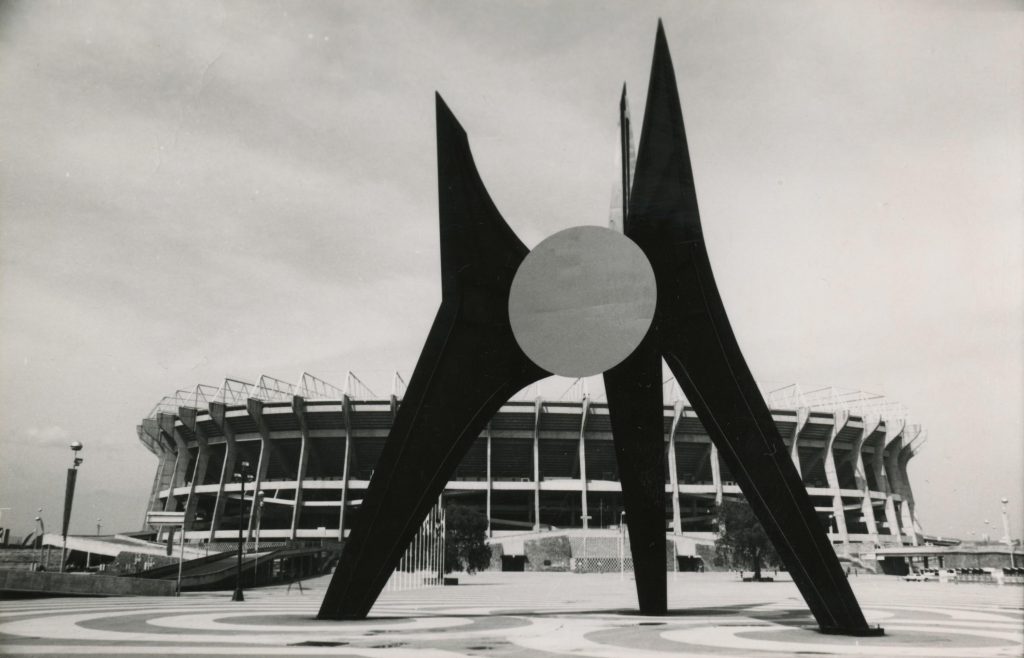
El Sol Rojo, 1968.
I find this latest one great—such another step toward clarity and monumentality. It looks like a perfect Mendelian cross between their culture and your insides.
Yes, I like it.
Each one now seems to become more distilled, simpler in means and therefore more powerful. How high is this? It looks enormous.
Eighty feet.
The bracing system against the wind and gravity looks so discrete.
Yes, and the other side has rather special reinforcements too. They were afraid it might blow down in hurricanes, but it seems to withstand them.
I like the utter economy of the color—that immense blackness and the other vermilion disk.
So do I.
When I got to Mexico—I’d sent a three-foot model of what I wanted ahead and suggested that they make one nine or ten feet high—they’d made this intermediate model and welded it all together. When I arrived they asked: “Now, where do we put the holes?”
They were going to bore them and bolt them after the fact. No matter, I like the way it looks.
The line between the painting and sculpture is becoming freer and freer, but on the whole you use it in these big pieces very economically—that one red disk in Mexico City against the black, the single overall orange on the thirty-foot dragon Tom Whitney bought. There are very few with three or four colors, unlike the joyous gouaches which you are now pouring forth. How important do you feel the color is in the sculpture?
Against certain backgrounds, yes—it can help. For instance, a new one at Grand Rapids will be red because the piece is set against a black glass building. Actually, it will be pinker than vermilion; it will be forty feet of raspberry. But otherwise, plain black will do it if I’ve made it right. One time Hilla Rebay came to me and asked if I would make a mobile for the middle of the Guggenheim. I said I’d make a big black one. She said, “Mr. Wright wants you to make it out of gold.” I said, “All right, I’ll make it out of gold, but I’ll paint it black.”
Whitney Museum of American Art, New York. Alexander Calder: July 22, 1898–November 11, 1976, Memorial Service. Memorial program. 1976.
Unpublished Document or ManuscriptLouisiana Museum of Modern Art, Humlebaek, Denmark. Alexander Calder: Retrospective. Exhibition catalogue. 1995. Louisiana Revy, vol. 36, no. 1 (Summer 1995).
Alexander S. C. Rower, License Plates
Magazine, Solo Exhibition CatalogueNational Gallery of Art, Washington, D.C. Alexander Calder: 1898–1976. Exhibition catalogue. 1998.
Arnauld Pierre, Staging Movement
Solo Exhibition CatalogueCalder Jewelry. Edited by Alexander S. C. Rower and Holton Rower. New York: Calder Foundation, 2007.
Alexander S. C. Rower, Calder Jewelry
Alexander S. C. Rower, Louisa James
MonographIn 1963, Calder completed construction of a large studio overlooking the Indre Valley. With the assistance of a full-scale, industrial ironworks, he began to fabricate his monumental works in France and devoted much of his later working years to public commissions. Calder died in New York in 1976 at the age of seventy-eight.